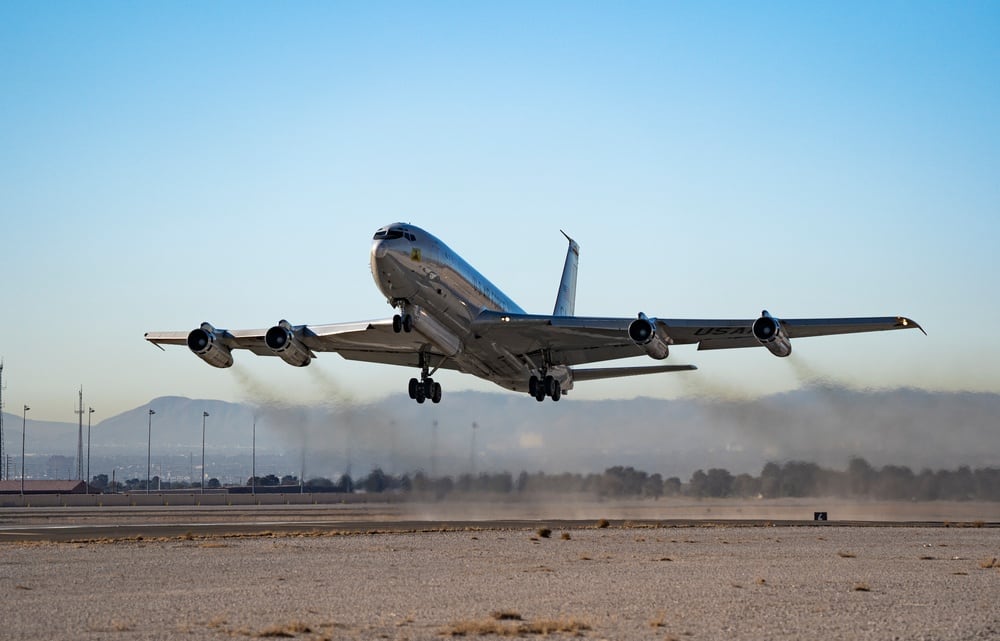Robins Air Force Base in Georgia retired its first E-8C ground target tracking plane earlier this month, marking the start of a divestment effort that has waffled for years.
JSTARS, or Joint Surveillance Target Attack Radar System, tail No. 92-3289 was the initial jet in a 16-plane fleet that arrived at Robins in 1996. On Feb. 10, it came full circle as the first to head to the aircraft retirement site known as “the Boneyard” at Davis-Monthan AFB, Arizona.
“The first retirement of a JSTARS aircraft gives us an opportunity to celebrate the operational accomplishments and the pivotal role the aircraft has played,” Col. Amy Holbeck, 116th Air Control Wing commander, said in a Feb. 11 release.
RELATED

Active duty airmen in the 461st Air Control Wing and Georgia Air National Guardsmen in the 116th ACW share the mission, which uses a massive radar on the jet’s belly to track where faraway ground forces are going and sends that data to other aircraft and troops below.
It has flown in military operations from Desert Storm in 1991 to Iraq and Afghanistan a decade later, to the ongoing surveillance of Russian troops amassed at Ukraine’s border, with counter-narcotics and many other missions thrown in as well. In 2019, the Air Force pulled the JSTARS fleet out of U.S. Central Command after an 18-year continuous deployment supporting counterterror missions.
“Aircraft 92-3289 and a pre-production E-8C flew almost 40 operational sorties and almost 500 flight hours” during Operation Joint Endeavor in Bosnia, the Air Force said. “Operation Allied Force [against Yugoslavia] saw Joint STARS in action again from February to June 1999, accumulating more than 1,000 flight hours and a 94.5 percent mission-effectiveness rate in support of the Kosovo War.”
JSTARS No. 92-3289 had many lives before joining the Air Force, including as a Qantas Airways passenger airliner, Robins said in the release. The fleet transported cattle for a time as well.
Though the fleet’s old airframes and frequent use have led to significant maintenance issues, this particular jet wasn’t one of the “hangar queen” planes that sat out of service for years.
“AF 92-3289 flew its last operational training sortie from Robins AFB on Jan. 27,” 116th Air Control Wing Capt. R. Dustin Cole said on Tuesday. “It was then prepped for retirement and departed Robins AFB for [the 309th Aerospace Maintenance and Regeneration Group at Davis-Monthan].”
JSTARS is beloved by soldiers for the help it’s given the Army in land wars over the years. Those that have benefited from its eye in the sky pushed back on the Air Force’s recent attempt to replace it with a newer airframe. In 2018, the service ditched that multibillion-dollar plan in favor of a networking initiative known as the Advanced Battle Management System.
ABMS was meant to take the place of JSTARS with a web of satellites, ground radars and airborne sensors to detect and track movement down below. It has since grown into a broader, overarching effort to funnel combat information between any Air Force assets and to the other armed forces. The plan is still in development.
RELATED

Robins expects to take on four new missions in place of JSTARS, though it’s still unclear how those will take shape. They include ABMS; a spectrum warfare group for electronic attack and defense across radio frequencies; a unit focused on managing and directing aircraft in combat; and a squadron of E-11A Battlefield Airborne Communications Node jets — heavily modified Bombardier business jets with radios and other systems that let aircraft share data in flight.
Three other JSTARS tails will head to the Boneyard by Oct. 1, though the Air Force hasn’t said when. The remaining aircraft will retire over the next few years, ending in the mid-2020s.
Rachel Cohen is the editor of Air Force Times. She joined the publication as its senior reporter in March 2021. Her work has appeared in the Washington Post, the Frederick News-Post (Md.), Air and Space Forces Magazine, Inside Defense, Inside Health Policy and elsewhere.





